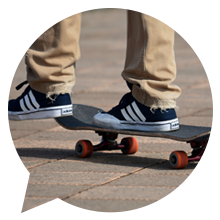Skateboarding safety

Introduction
It should be appreciated that skateboarding is an exciting sport and that accidents will occasionally occur. RoSPA will normally Risk Assess all skate parks as being high risk. That does not mean that we do not approve of them, just that we recognise that accidents are going to occur.
Accidents
Whilst acknowledging that in putting in a skateboard facility you are going to have accidents occurring, it should also be recognised that the number and severity of accidents that will occur to participants in wheeled sports in the area will be much higher if such a facility is not provided. The main statistics for skateboarding are from the USA. They show that between January 1992 to June 1995 there were 25 deaths due to in-line skating and 100 deaths involving BMX bikes etc. 90% of these involved collisions with motor vehicles. The numbers of fatalities on skateboards was too small to be recorded nationally and are almost exclusively due to collisions with motor vehicles.
To put things into perspective, there were 35,788 skateboard injuries in 1996 and 156,681 football (soccer) related injuries (again in the USA). However skateboarding injuries tend to be more serious than football related ones. A third of all skateboarding injuries occur at weekends. The average age of skateboarders is between 13 and 14 and they participate in the sport on average 50.8 days in the year. 90% of them are male and 60% are under 15.
Sprains, fractures, contusions and abrasions are the most common form of injury. 74% of injuries were to the extremities. Among these broken wrists (19%), ankles (11%), face (16%) and long bone fractures are the most common injuries. Head injuries accounted for around 20% of all injuries. Serious injuries, concussion, blunt trauma, skull fracture or closed head injuries represented 3.1% of all injuries to skateboarders. Most serious injuries would have been prevented if correct protective gear had been worn.
Approximately a third of those injured have less than one week's experience of the sport – so keep a close eye when you first open a new facility. The most commonly injured participants are those with over one year's experience. Accidental falls due to loss of balance are the most common with about half of falls due to rough riding surface. Small stones, sticks, bumps and holes in or on the riding surface are the leading cause of falls of experienced riders.
Underdeveloped motor co-ordination is the main cause of falls to younger and less experienced riders. In addition, the smaller the child the higher their centre of gravity due to the larger proportion of their head to body. Because of this, and the inability of less developed children to brace properly for a fall, head injuries account for a much higher proportion of injuries for skaters under 10.
Most statistics courtesy of US Consumer Products Safety Commission
Management of litigation
You are only liable for damages, under UK law, if you are negligent. If you take all recommended steps it is unlikely that you will be deemed negligent and therefore if litigation occurs, you are less likely to have damages awarded against you. You are not exactly fireproof but you are certainly strongly flame resistant. There is a new Publicly Available Specification (BS EN 14974) from BSI that covers skateboarding facilities. Work is also near completion on a European Standard.
Reducing accidents
RoSPA recommends the following action:
- involve skaters and other users in the development and management of the facility
- discuss siting of the provision with the local police architectural officer
- site the facility so that it is overlooked (this gives some informal supervision) and is away from overhanging trees etc.
- make sure that there is good access for emergency vehicles
- ensure there is good, firm access to the area
- ensure that correct signs are provided (see BS EN 14974 for an example)
- ensure that all equipment is built and installed to BS EN 14974
- obtain a post installation inspection from a suitably qualified body such as RoSPA to ensure safety standards are met. (Your insurance company may insist on this)
- inspect your site regularly. Even in a small parish this must be a minimum of once a week
- ensure users know where to report faults
- obtain an independent annual inspection of the site. RoSPA can undertake this inspection at the same time as it is inspecting play areas
- document all inspections and keep records for as long as possible. (RoSPA recommended a minimum of 15 years)
- undertake all repairs/maintenance problems as soon as is practical
- if this cannot be done, take the equipment our of use as far as is possible
- inform your insurance company
In addition you can take the following precautions with regard to users:
- encourage the wearing of correct "gear". Research indicates that skaters tend to wear helmets, or fail to wear them in groups. If one child is wearing a helmet there is an 85% chance that the next child will wear one. If the first child is not wearing a helmet there is only a 3% chance that the second child will
- wearing of wrist protection will greatly reduce accidents and may be perceived as "more cool"
- on new sites encourage the more experienced skateboarders to show the less experienced ones how to fall